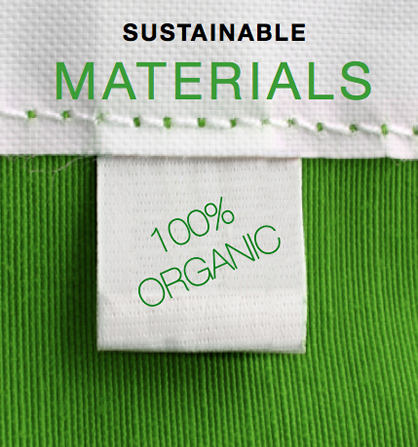Going Green in Your Closet: Eco-Friendlier Fabrics
It’s time to green up your closet. Fabrics such as soy, hemp and bamboo offer a natural, eco-friendly alternative to mass-produced cotton and animal fibers. Next time you are picking out a new piece to add to your closet, consider purchasing one of these environmentally preferred natural, organic or recycled fabrics.
SOY FABRIC
Made from the waste product from the hulls of soybeans then processed into a fiber, soy fabric is known as “vegetable cashmere” for its soft and silky feel. In addition to recycling the byproducts of soybean oil and tofu production, it is eco-friendly because it is very renewable, contains no petroleum, and biodegrades more easily than some of its other less green peers. As it absorbs dyes quickly, it also often uses less dye-stuffs. The chemicals used to process the fibers can be recycled and reused again. Resistant to bacteria and UV rays, soy fabric is easy to care for. Throw it in the washing machine and dry it at a low setting. Although invented in 1937 by Henry Ford, soy fiber is just beginning to truly hit the scene. While China has started to mass produce soy-based yarn, soy clothing is mostly restricted to underwear, socks, scarves, sheets and exercise apparel. It is prized for its anti-wrinkle properties, moisture absorption, antibacterial nature and superior ventilation.
BAMBOO
As hypoallergenic, absorbent, fast-drying and naturally antibacterial, bamboo is one of the hottest new eco-friendly fabrics. Soft and breathable, bamboo is similar to a combination of silk and cashmere. Because bamboo is the fast-growing plant on earth, it requires less land, less care and less pesticides and fertilizers than other crops. Naturally disease and pest resistant, bamboo does not require fertilizers or pesticides as it contains bamboo kun, a naturally occurring substance that fights off disease and insects. Some kinds of bamboo can grow up to 4 feet in just one day and the plant can be harvested in three to four years. Plus, the plant actually improves the soil and eliminates erosion. Long used for housing, flooring, furniture and more, bamboo is now often made into clothing using a relatively newer process produced by the Beijing University in 2001. To process it into a fabric, the plants fibers inside the tough bamboo cane are converted to pulp and changed into bamboo viscose, a material like rayon. This processing of the fibers involves using somewhat unsafe chemicals to breakdown the plant, making bamboo slightly less desirable natural option, although the industry is attempting to eliminate these downsides and certification of manufacturers using safer chemicals exist.
HEMP
Hemp hits a lot of high notes when it comes to being planet-friendly. It is a highly productive, fast-growing crop that is simple to cultivate and tolerant of pests, requiring little water and few chemicals to grow because its crowded foliage blocks the growth of weeds. Some of these same qualities make it a cost-effective material as it is cheap to farm. Its deep roots renew the soil and retain topsoil. Generating more fiber per acre than trees, hemp can be renewed a few times each year. The fibers are separated than spun and woven into textiles. Once politically undesirable, hemp is making a comeback as an oil and food plant in addition to a fiber. Its agricultural version has no value as a recreational drug. A highly durable material, hemp fabric is known as a miracle fiber: strong, soft, lightweight and long-lasting. It is three times stronger than cotton and far more durable. Hemp’s cellulose fiber can be converted to everything from jeans and shirts to bags, ropes, canvas, skin care, paper and food. Each part of the plant is used: The seeds are made into oil and food and the stalks because fiber. New innovations have enabled the fabric to be manufactured with a similar whiteness and softness to cotton. Commercially produced in Europe, Russia, China and Canada, hemp still has not been legalized as a crop in the United States.
ORGANIC COTTON
Cotton is well-established as one of the most environmentally destructive agricultural crops, accounting for 50 percent of the international pesticide/herbicide use. Cotton farming also consumes huge quantities of fertilizers and water. Cotton supplies half of the planet’s need for fabric, pushing farmers to use more chemicals to meet this demand. Organic cotton fabric goes far beyond simply sourcing from organic cotton. From start to finish, the process is monitored to be eco-friendly. No toxic heavy metals, formaldehyde, aromatic solvents or genetically modified organisms may be used in processing, and all bleaches are oxygen-based and not chlorinated. The majority of organic cotton fabrics do not use organic dyes and inks due to problems with availability, choosing instead to go with low-impact dyes with short dye cycles that do not have heavy metals or other toxins. Often available for similar prices as conventional cotton, organic cotton uses methods with minimal environmental harm. Moreover, organic cotton fabric is just as soft, durable and delicate as conventional cotton fabric.
RECYCLED POLYESTER
Polyester is the leading synthetic fiber, accounting for around 70 percent of synthetic fibers. As synthetic, polyester is less eco-friendly than other, natural fabrics, even when recycled. How green it is depends on the recycling process employed. Reused polyester uses 33 to 53 percent less energy to produce than virgin polyester. Polyester fibers are often manufactured from used clothing or from recycled plastic containers. Known as polyethylene terephthalate (PET) in textile production, most PET is directed to textile use, with about 30 percent winding up as bottles. Very few of these bottles are recycled into fibers. In addition, PET production runs through 104 million barrels of oil each year. Recycled polyester helps the planet by saving energy and diverting plastics out of landfills.
Tagged in: eco, green, sustainable, organic, eco-friendly,

LadyLUX



